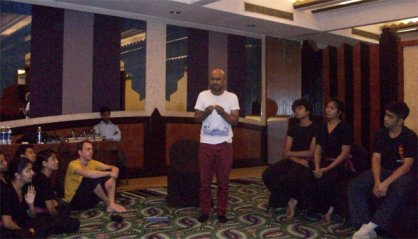
|   |

|   |
Gnosis by Akram Khan Dance Company - Nita Vidyarthi, Kolkata e-mail: nitavidyarthi@gmail.com November 17, 2012 Seldom does euphoria travel transcontinental. But it did exactly that from the West to India this September for one of the world’s top ranking choreographer and contemporary dancer, Akram Khan. After starring in the opening ceremony of London Olympics 2012, Akram created waves in six Indian cities in September as a part of The Park’s New Festival and as the opening showcase of ‘Impulse,’ a season of UK contemporary dance organised by The British Council. Impulse brings five key tours by fantastic UK dance companies in the next six months, also incorporating an array of outreach with dance organisations in India and the young people in the country, workshop-leadings, discussions, networking, collaborating and building new relationships. At Kolkata, prior to his performance, the dance lecture by Khan organised by The British Council at The Park focused on choreographing and directing with reference to his own work, while answering questions and sharing his thoughts and advice on choreographic process crystallised in the past 11 years. He mentioned the encouragement of his parents, particularly his mother’s for his love for the arts, especially dancing while discussing his training, foray into Kathak, his gurus and then his earlier contemporary work experiences with acclaimed artists like Sylvie Guillem, Sidi Larbi Cherkaoui in collaboration with Antony Gormley and composer Nitin Sawhney. Some young dancers present were given a short stint of improvisation tasks like expressing joy, anger, fear, from neutrality through facial expressions only, while setting a definite body boundary. The first half of the performance at Kalamandir was concentrated on Akram Khan’s wizardry over nritta - pure dance mainly footwork in classical Kathak. His thunderous entry with “Jai Shiva Shankar” of the piece “Polaroid Feet” was enough for the audience to know what high standard of dancing was in store for the evening. A tukrah with subtle jerks and lyrical hastas were followed by the Tandava and lasya elements in this ‘Ardhanarishwara’ piece “Shankara Shiva Gangadhara” which had the aroma of Natavari nritya. The long body stretches, wrist movements and anagat tatkar in the piece choreographed and set to music by none other than Gauri Sharma Tripathi was impeccably rendered with the naghma on the cello by Lucy Railton -the first ever for a traditional Kathak performance. 

In Tarana choreographed by his Guru Pratap Pawar, he showed his technical virtuosity and intricate footwork, all along refraining from the common practice of striking the foot hard, producing an unpleasant and disturbing thump. Kolkata is lucky to have watched his control and precision of footwork, powerful yet astonishingly subtle. He is referred to as an explosive dancer and the jugalbandi with the accompanists, Sanju Sahai on the tabla, Bernhard Schimelsberger on drums and percussions, Kartik Raghunathan on the violin, cellist Lucy Railton and Faheem Mazhar on vocals (all from UK) proved to be aesthetically beautiful. ‘Allah” was a successful spiritual piece portraying his abhinaya skills. In contrast, the second half showcased his recent award winning contemporary work ‘Gnosis’ on transformation inspired by the Mahabharata, the story of Gandhari in particular, who blindfolds herself for life to share the journey of her husband. It explores the notion of inner knowledge and clouded vision, seeing darkness and yet being blind to light. She was accompanied on stage by guest artist Fang-Yi Sheu from Taiwan, the former lead dancer of The Martha Graham Dance Company and his competent musicians on stage. Gnosis (knowledge in Greek) is deeply rooted in classical Kathak and Khan’s modern dance training. As each of his creations are signature pieces, Gnosis showcases intelligent artistic movement narratives. The performance comprising five scenes mirrors transformation, culminating in a shattering conclusion. Amidst the gradually expanding triangular beam from the rear “top light” on the dark stage, enters Fang-Yi Sheu, with easy movements, subtle body inflexions, arm movements subordinated with controlled lines and then a commendable straight still look as the blindfolded Gandhari, praying to Lord Shiva for children. This was the first scene, the ritual of birth. With Akram’s captivating entry as Duryodhana, the narrative takes the usual course of the epic in the next 4 scenes to the final one of death, mourning and fire. The growing up and playful gestures between son and mother were stimulated by floor rolls by Akram and were natural actions with aesthetic hues. In stark contrast as the greedy and ambitious man, his powerful limb stretches, graceful body raises, twirls and twists and contact improvisations with Fang-Yi Sheu were startling. Akram was amazingly supple and skilful while weaving a few Kathak movements like chakkars and footwork seamlessly into the choreography, never for a moment slipping from his high key of style and embodiment of character. The coordination of vocabulary, use of space and positions were accentuated with abstract movements truly original and creative with gradually progressing red light of bloodshed, grief and retreat of Gandhari to the Himalayas. Akram’s whole body emotes brilliantly. His lines are superb and execution undoubtedly an explosion of movement, colour and music. An unforgettable performance by an extraordinary dancer. Nita Vidyarthi is a critic of performing arts, specialising in dance, dance theatre and expressions and is a regular contributor to The Hindu, and the Statesman Kolkata in dance, vocal music and theatre. She is trained in Kathak, Bharatanatyam and Manipuri as well as vocal, semi-classical music and Rabindra Sangeet. A Science communicator, Ph.D. in Polymer Science, Commonwealth Scholar and a retired Professor of Chemistry, Nita devotes most of her time to dance and theatre writing. |